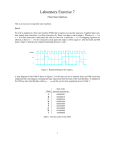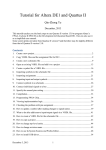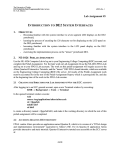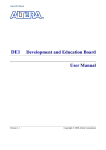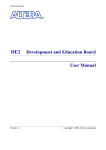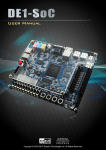Download Lab-3 - cs.csub.edu - California State University, Bakersfield
Transcript
California State University, Bakersfield
Computer & Electrical Engineering & Computer Science
ECE 322: Digital Design with VHDL
Laboratory 3
Rational: The purpose of this lab is to introduce the student to the following key concepts
and ideas.
1. Using VHDL and the compiler built into Quartus II as a Logic Synthesis tool to replace
schematic capture.
Abstract:
In lab 2, you learnt how to design a simple logic system (a BCD to 7-Segment decoder) the
hard way, by translating the requirements for a logic system into a truth table and then
optimizing the Boolean expressions prior to drawing the schematic diagram using basic
gates, simulating and downloading to the DE2.
For relatively simple problems such as the BCD to 7-segment LED display driver, this was
not too onerous a task, however, when digital systems become more complex, designing
circuits out of individual gates is tedious, time consuming and very error prone.
In this part of the lab we are going to use VHDL to synthesize a logic system from simple
textual descriptions of the requirements of the system, i.e. its behavior. We shall then compile
the code and download to the DE2 board.
In other words, we are going to compare the manual process of designing and producing
digital circuits using truth tables, Boolean equations and basic logic gates vs. that of using a
VHDL compiler to synthesize the (optimized) design from our description of the circuit
behavior.
To simplify the comparison, the problem will start off being the same as the lab 2 namely
the BCD-to-7 segment display driver problem but, just to make it slightly more
interesting, we will enhance it later on in the lab to implement a Hex-to-7 segment display
able to display the digits 0-9 and A-F.
In addition, we will see how easy it is to create an arithmetic unit in VHDL
What do I have to demonstrate?
You have to demonstrate Parts D, E and F below (which implies that you have done Parts A,
B and C), running on the DE2 boards and also show your VHDL code and schematics
(where relevant) to the TA.
Part A:
Step 1: Create a new project in Quartus II called BCD (since this is the name of the top level
entity/circuit in the project – see code below)
Step 2: Create a new VHDL file (menu File->new) and save it as BCD.vhd. Describe the
entity (real-world input and output signals as buses) plus an architecture looking like this.
You can cut and paste the text below into your VHDL file.
LIBRARY ieee;
USE ieee.std_logic_1164.all;
ENTITY BCD IS
PORT(
Inputs : in std_logic_vector(3 downto 0) ; -- inputs A,B,C,D
Display : out std_logic_vector(6 downto 0) -- outputs a,b,c,d,e,f,g
);
END;
ARCHITECTURE Behavioural OF BCD IS
BEGIN
PROCESS(Inputs)
-- process sensitive to changes in these signals
BEGIN
-- describe how the values of ABCD in range {0000 – 1001}, i.e. 0 – 9
-- map to abcdefg using if-else statements etc
if(Inputs = "0000") then
Display <= "
";
-- fill in the required 7 bit value
elsif(Inputs = "0001") then
Display <= "
";
-- fill in the required 7 bit value
.
.
.
.
else
Display <= "
end if ;
END PROCESS ;
";
-- fill in the required 7 bit value
-- end of the process
END;
Now fill in the missing statements inside the „PROCESS‟ to describe how the inputs map to
outputs, using if…elsif…else statements. Your truth tables from Lab 2 will help.
Step 3: Make sure you can compile the project successfully.
Step 4: Create a logic symbol for the BCD decoder (click on menu file->create/update->create
symbol files for current file). Now create a new block diagram file and place the new symbol
for your BCD decoder onto it. Save the block diagram file as BCDto7SegDecoder.bdf
Step 5: Make the above new block diagram file the top level entity in your design (in the
project navigator window, click on the files tab and then right click on your new block diagram
file and select „Set as top level entity‟)
Step 6: Create pins for the symbol (right click on your logic symbol on the block diagram file
and select „Generate pins for symbol ports‟).
Step 7: Recompile to check for errors.
Step 8: Using the Quartus II pin planner tool, assign the inputs above to four slider switches on
the DE2 board (use the DE2 user manual to look up the pins). Take care that you map them
correctly, for example, is Inputs (0) above in the entity declaration the „A‟ input or the „D‟
input? Likewise is the signal Display (6) the segment „a‟ output, or the segment „g‟ output.
Finally does a logic 0 or logic 1 applied to the LED in the 7-segment display to light up?
Step 9: Recompile.
Step 10: Download the .sof file to the DE2 board and check operation.
Step 11: Add extra statements to the VHDL PROCESS block above to decode the binary
values 1010, 1011, 1100, 1101, 1110, 1111 and thus display the letter A, B, C, D, E, F on the 7
segment display (you‟ll have to figure out which segments need to be turned on to create A, B,
C, D, E, F on the display. Note you can use upper or lower case A, B, C, D, E, F). Don‟t forget
to recompile!!!!
How easy was this compared to truth tables, Boolean Algebra/Karnaugh Maps and complex
gate level schematic capture?
Part B:
Mirroring the steps we did in Part A above, start a new Quartus project and design in VHDL a
priority encoder with 16 inputs (that you will eventually connect to the 16 slider switches on
the DE2 board). The circuit should output a 2 digit BCD code corresponding to the number of
the switch with the highest priority that is active, e.g. if switches 5 and 16 are active (logic 1),
then the output from your priority encoder circuit should be (in binary) 00010110 i.e. 16 in
BCD. Hint: use if-elsif-else type statements similar to Part A above to map inputs to outputs. If
no switches are active, the output should be 0000 0000.
Make sure you know which way around the switches are connected, is the switch in the „up‟
position generating a logic „1‟ or a logic „0‟ ?
Add a further single bit output called „Active‟ that is „0‟ when none of the 16 slider switches
are active, and „1‟ when at least one of them is active.
Create a new logic symbol for the Priority Encoder and paste this into a new block diagram, (a
file in Quartus. Make the new block diagram file your “top level entity” as you did in Part A
above.
•
•
•
Generate pins for the new Priority Encoder symbol (as you did in Part A) to represent
the real-world inputs and outputs.
Compile to check for errors.
Use the pin planner to map the inputs to 16 slider switches and outputs to the 8 Green
LEDs. The „Active‟ output can be mapped to a single red LED.
Compile and download the „.sof‟ file to the DE2 board and verify the operation by changing the
switches and checking that the appropriate LEDs light up.
Part C:
Start a new Quartus project, as we did in Part A and Part B above and create a new VHDL file
to describe the operation of a 4-1 multiplexer with four 4 bit inputs called „A‟, „B‟, „C‟ and „D‟,
and a single 4 bit output „X‟. Your circuit should also include a two bit channel select input „S‟.
1. The 4 bit inputs „A-D‟ can be mapped in the Quartus pin planner to the 16 slider
switches on the DE2 board SW0-SW15. Make sure you know which way around the
switches are connected, is the switch in the „up‟ position generating a logic „1‟ or a
logic „0‟ ?
2. The output X can be mapped in the pin planner to any of the 4 individual LEDs on the
DE2 board. (The single LEDs turn „on‟ when logic 1 is presented to them, unlike the
7segment displays).
3. The input „S‟ can be mapped in the pin planner to two of the 4 push buttons on the DE2
board, these push buttons produce a logic 0 when pressed.
Create a symbol for the multiplexer and paste this into a new schematic diagram, (a block
diagram file in Quartus). Make the new block diagram file your “top level entity” as you did in
Part A and B above.
•
•
•
Generate pins for the new multiplexer symbols (as you did in Part A/B) to represent the
real-world inputs and outputs.
Use the pin planner to map the inputs and outputs to switches, buttons and LEDs.
Compile to check for errors.
Compile and download the „.sof‟ file to the DE2 board and verify that by changing „S‟, the
output „X‟ is set to the 4 bit value of either „A‟, „B‟, „C‟ or „D‟ as defined by the switches, thus
implementing a 2 channel, 4 bit multiplexer.
Part D
• Create a new VHDL “hexto7Segment” file as part of the same project that you created
in Part C above and paste the VHDL code from the file we wrote in Part A (the
hexto7segement decoder) into it.
•
Create the logic symbol for the hexto7Segment file and paste the symbol onto the top
level schematic file that you already have in this project (the one with the multiplexer
on it).
•
Connect the 4 bit output „X‟ from your multiplexer to the 4 bit input of your hex to 7
segment decoder.
•
Generate pins for the output of the 7 segment decoder to represent the real world
outputs, recompile to check for errors then using the pin planner map these to one of the
7 segment displays on the DE2 board, e.g. Hex0.
•
Recompile, download and verify that the BCD display now displays in Hex, either of
the „A-D‟ switch settings when you press the 2 push buttons that select the input
channels of the mux.
Part E
Using the project you already have from Part D above create a new VHDL file, plus a symbol
for it (which you can paste onto the existing schematic diagram from Part D above) to compare
four 4 bit unsigned inputs „A-D‟ (which come from the slider switches and also go into the
multiplexor) and turn on one or more of the 3 spare Red LED‟s on the DE2 according to the
following comparisons. Simulate and Test the operation on the DE2 board. (don‟t forget to set
up the pins in the pin planner)
A=B=C=D
A > B and A > C and A = D
<= B or (A < C and A != D)
(turn on Led 1, off otherwise).
(turn on Led 2, off otherwise). A
(turn on Led 3, off otherwise).
Part F
Starting a new project, design a circuit in VHDL to perform simple arithmetic/Boolean
operations on two 8 bit unsigned inputs „A‟ and „B‟ (set using 16 slider switches on DE2
board). The result (including any carry/borrow and overflow output in the case of
addition/subtraction) should be displayed on red or green LEDS, you choose which.
A+B
Add A to B
A–B
Subtract B from A
A and B
AND each bit of A with corresponding bit in B to produce 8 bit result A
or B OR each bit of A with corresponding bit in B to produce 8 bit result
The operation is defined by the two remaining slider switches not allocated to A or B.
Note that to produce the carry/borrow output during addition/subtraction, it will be necessary to
make A and B temporarily into 9 bit operands using a leading 0 in the m.s.b. position
(investigate the „&‟ operand in VHDL to concatenate or merge signals in a bus. We can then
add the 9 bit operands using a 9 bit adder and the m.s.b. of the 9 bit result will be the value of
the carry/borrow).






